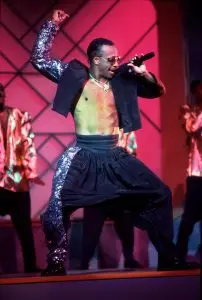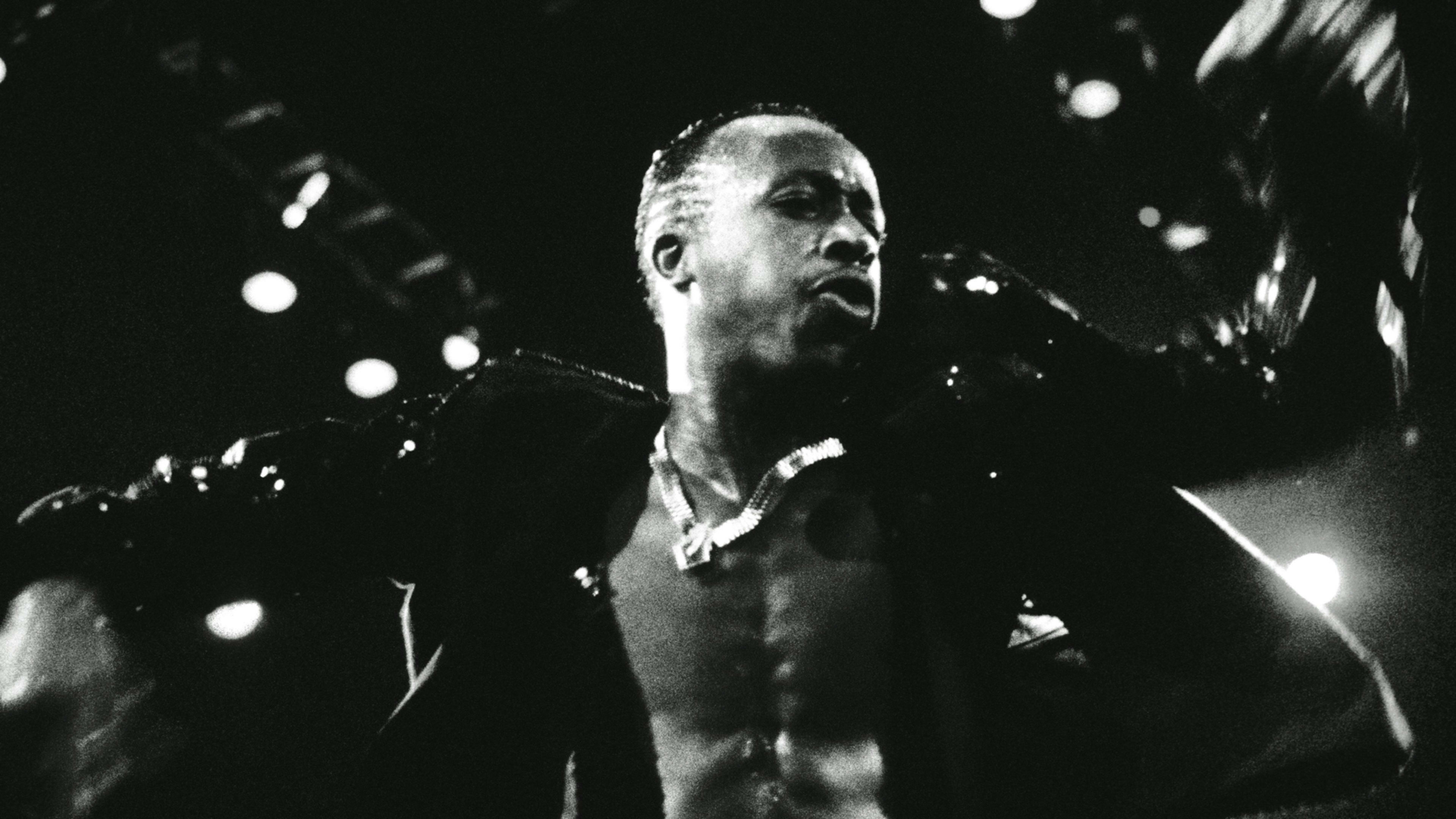On January 13, 1990, MC Hammer released the lead single from his second studio album that catapulted him—as well as hip-hop at the time—into the mainstream stratosphere.
“U Can’t Touch This” became the first hip-hop song to reach No. 1 on the Billboard Hot 100. Its album, Please Hammer, Don’t Hurt ‘Em, became the first hip-hop album to reach certified diamond status, selling more than 10 million copies.
But what truly cemented Hammer in pop culture history were the visuals that accompanied the infectious pop-hip-hop track.
The music video for “U Can’t Touch This” introduced the world to Hammer’s signature harem pants, and, of course, what’s come to be known as “The Hammer Dance.” Hammer had danced in previous videos such like “Turn This Mutha Out”—and “U Can’t Touch This” certainly showcases how smooth he is at the Running Man, the Bump, and hairpin twirls. However, at around two minutes in when Hammer first yells, “Break it down!” there’s a 15-second long single take (the longest in the video) where Hammer rapidly shuffles from one side of the stage to the other.
The Hammer Dance was born.
But if Rupert Wainwright, the director of the “U Can’t Touch This” music video, had had his way, that scene would’ve never seen the light of day.
When Wainwright Met Hammer
Wainwright, who most people may know as the director of Blank Check, The Fog, and Stigmata, got his start shooting music videos. As a U.K. native, Wainwright came to the U.S. in the ’80s on a Fulbright scholarship where he earned his MFA in film directing at UCLA. He’d directed a few music videos here and there, but his passion was always in film. At one point, he was working on a short but ran into a wall when the production company alerted him that he was $10,000 over budget.
“I was a student at the time, so I’m like, I can’t even conceive what $10,000 looks like. I don’t even think I can spell it,” he says. “Literally 10 minutes later, the phone rings, and the guy goes, ‘Hi, this is MC Hammer. I’m calling from Capitol Records.'”

“The honest truth is I wasn’t big into rap at that time,” Wainwright says. “And I wasn’t really interested in doing music videos. All the videos I’d done were with white disco divas, and I was like, god, I hate this shit. It’s like three hours between every shot while they fixed their makeup. It was horrible. I just needed the money to pay for [my short film.]”
Wainwright took the job and fully expected to breeze through the shoot.
“We were like, we’ll do a good job, but it’s Saturday—let’s, like, knock off early,” Wainwright says. “And this tour bus turns up and the dancers came out and this, like, sergeant major’s voice started booming. I couldn’t believe it. It was the most organized thing you ever saw in your life.”
Due in no small part to his three-year stint in the Navy, Hammer (born Stanley Kirk Burrell) has been referred to as “a demanding taskmaster,” who, according to a 1990 Rolling Stone cover story, would fine members of his entourage $100 if they broke curfew on tour.
“We were like, so impressed by their dedication, their organization, their drive, their talent, everything,” Wainwright says. “And we just went all day. We shot for, like, 22 hours. It was crazy.”
That’s what kicked off what would become a longstanding relationship between Hammer and Wainwright.
U Won’t Touch This dance break
Wainwright even managed to get the best of both worlds with cinema and music when Hammer came to him with an idea to shoot a movie musical for his second studio album. Please Hammer, Don’t Hurt ‘Em: The Movie is one of the forerunners in the visual album format, weaving four tracks from the album into a narrative story that would be spun into separate videos.
“When you do four videos all at once and it’s all done as a musical, it works great altogether,” Wainwright says. “But you need a bit of variety when you’re releasing singles.”
So while Wainwright was beginning production on the TV movie Dillinger, he got a call from Hammer.

“He would always call me at four in the morning and give me a whole bunch of instructions and then hang up,” Wainwright adds. “I used to go to bed with a pen and paper beside my phone, so I could just scribble it down, because I would wake up the next morning and go, ‘What the fuck did he say?'”
Wainwright’s instructions were to go pop—and that he did. For example, when it came to the song’s lyrics, “I’ve toured around the world, from London to the Bay,” Wainwright envisioned cutting to a shot of a guy in underwear with the British flag on it.
“Let’s make it as funny and as silly as possible,” he says of his game plan. “I wanted to make it a video that like you had a smile on your face from beginning to end.”
Although there were no underwear shots to speak of in the final cut, there were splashy colors, tilted camera angles, and, most importantly, high-energy dancing.
“‘Great video, Rupes,'” Wainwright recalls Hammer saying when he sent him a cut. “But you messed it up in the editing.”
Wainwright had cut the Hammer Dance from his version.
“He goes, ‘You’ve got to put that in—no edits, just a straight shot,'” Wainwright says. “I’m like, ‘Hammer, I love you man. But that is crazy. Nobody wants to watch you dance uninterrupted for 15 seconds.”
Hammer pushed back and Wainwright relented, telling him to sit with the editor and use whatever footage he wanted. While beginning shooting for Dillinger in Toledo, Ohio, Wainwright was FedExed a VHS of the final cut for “U Can’t Touch This.” Much to his chagrin, there was the dance break.
“I looked at it with the art director [of Dillinger] and I said, ‘Thank god I’m doing a TV movie because this music video will finish me in this business,” Wainwright says.
In a way, he was kind of right.
The video was a smash success, which somewhat pigeonholed Wainwright.
“That video ended up ending my music video career,” Wainwright jokes. “Every video I did after that all people wanted was ‘U Can’t Touch This.'”
Although requests coming in weren’t that creatively diverse for Wainwright, Hammer’s high concepts kept him fulfilled and eventually led to his big break.
Mr. Katzenberg will see you now . . .
Hammer recorded the single “Addams Groove” for the 1991 film The Addams Family and, once again, tapped Wainwright to direct the video. It opens with Hammer getting his head sliced off by a guillotine. But that doesn’t stop him from rapping and dancing throughout the Addams’ mansion.
While having lunch at Los Angeles’s fabled eatery Musso and Frank’s, Wainwright says an executive at Disney approached him.
https://www.youtube.com/watch?v=jqQwzgixHAM
“‘You directed “Addams Groove,” right? I’m going to send a messenger to your office: I need a VHS tape of that for [then Walt Disney Studios chairman Jeffrey Katzenberg’s] kids before the end of the day,'” Wainwright says. “Next thing you know, Katzenberg calls me up and puts me on the movie Blank Check.”
Wainwright isn’t shy in expressing how much working with Hammer has impacted his career. With Wainwright’s credentials, he certainly would’ve found his way into film eventually. But the fact that Hammer was so fastidious in making sure he was along for his meteoric rise in the ’90s definitely didn’t hurt.
“He is the most loyal, fabulous guy I ever had the chance to work with in the music business,” Wainwright says. “He never hired anybody else. There was a lot of pressure on him to bring in some black director instead. I’m from England and very white. But he was like incredibly loyal. He was like, ‘Rupert’s my guy.’ And that’s the way it was.”
Recognize your brand’s excellence by applying to this year’s Brands That Matter Awards before the early-rate deadline, May 3.
